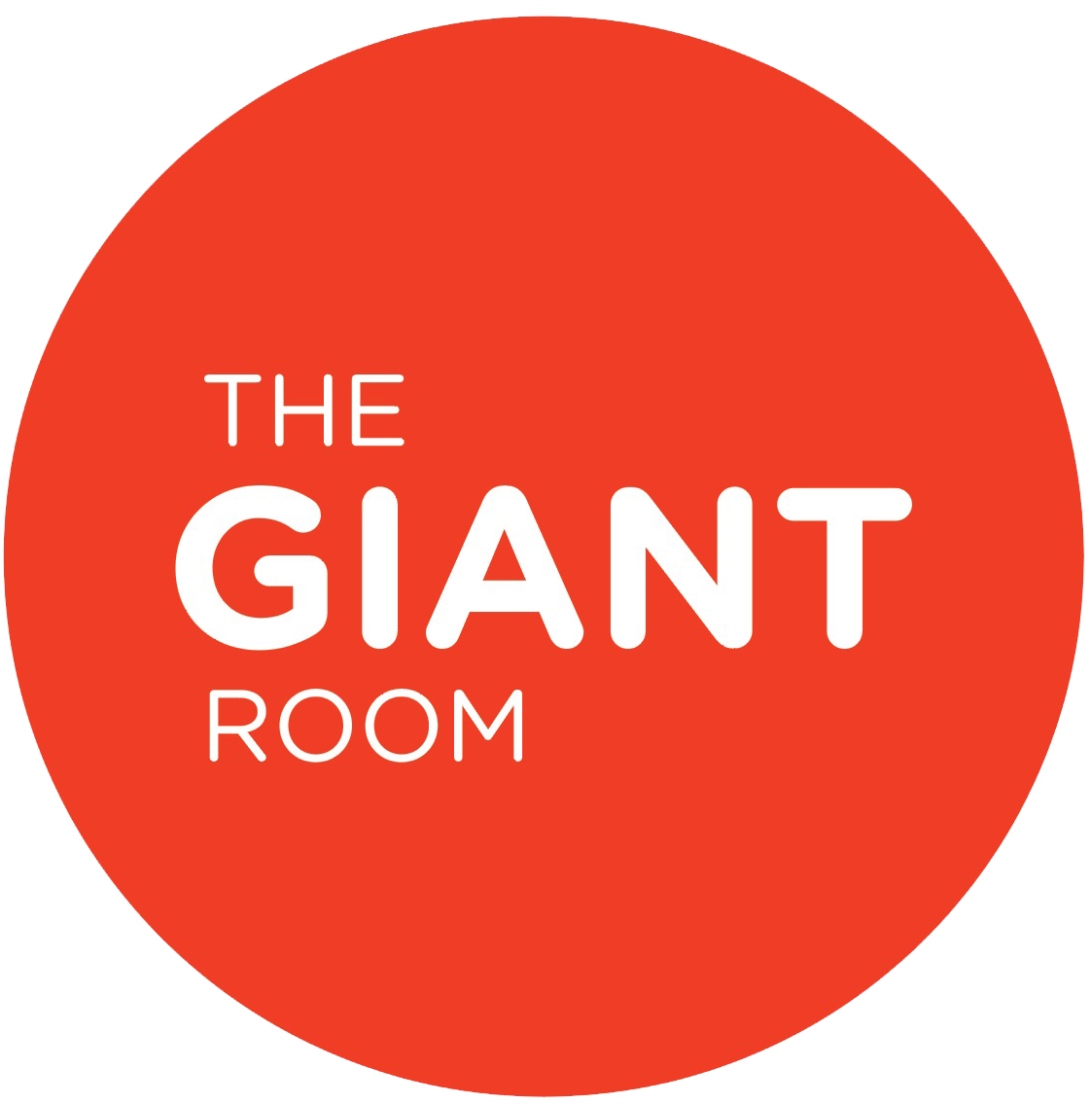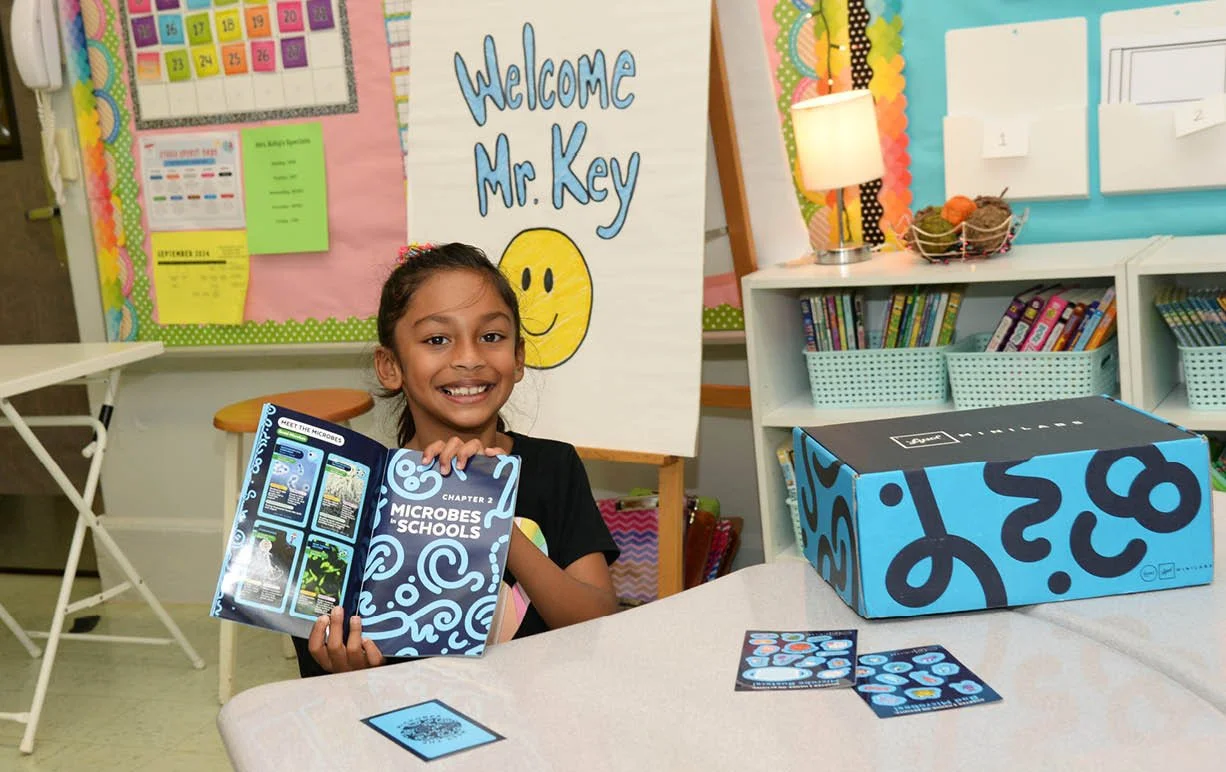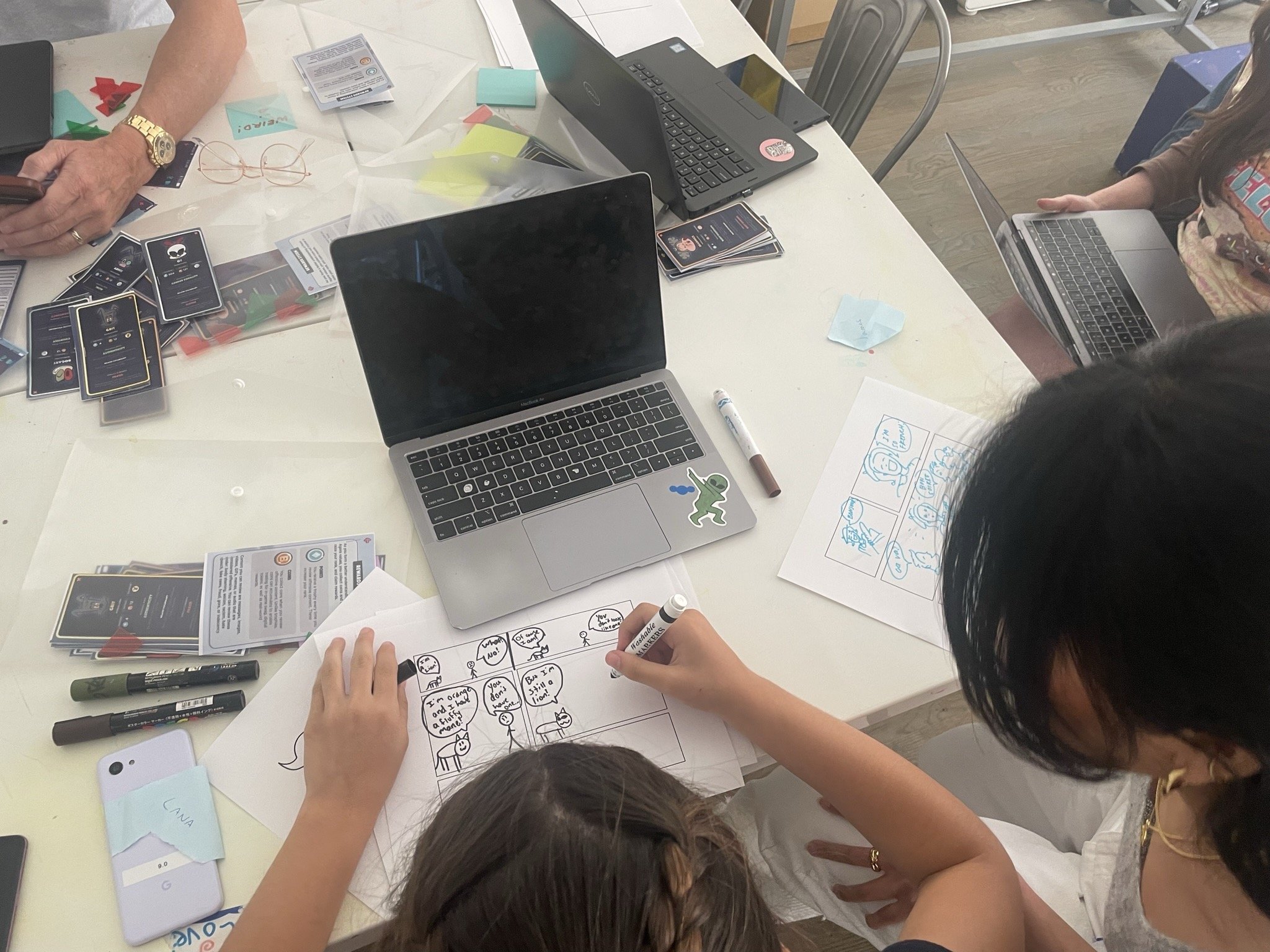GIANT DesignLab UX Methodologies
The GIANT DesignLab is the design and research arm of The GIANT Room that partners with edtech companies, digital media innovators, toy designers, and children’s product/service providers to help them build experiences that are effective and engaging for kids.
The DesignLab mission is to bring diverse groups of kids’ voices and needs into the design process of the products that are being designed for them. Oftentimes, adult designers are remote from kids’ worlds, and so they design products for an “imaginary” user that may be very different from the actual kids they’re designing for. As a result, their final products fail to connect with kids and miss important metrics of engagement, learning outcomes, desirability, and customer return. On the other hand, by giving kids, caregivers, and educators seats at the design table, designers can ensure the products they design address the needs of their real users, provide an engaging experience for them, and result in positive measurable outcomes.
We also want to connect kids to real designers in the field so they can start believing in their own ideas, gain creative confidence, and see themselves as agents of change. As kids interact with designers and learn about the behind-the-scenes of real products, they develop more trust in their own design process, become more forgiving of their own failures, and start internalizing that prototyping, testing, and refining their designs are necessary steps to bring their ideas into the world.
Led by The GIANT Room’s founders with PhDs in cognitive science and science education, and years of experience in research and product design, The GIANT DesignLab works closely with their industry partners to assess their product design needs, identify the best methodologies that answer their most pressing questions, and plan for a research/design feedback loop that results in highly engaging and effective products that are good for kids’ wellbeing.
Here we outline a suite of research methodologies our team has expertise in - depending on our partners’ product development phase, budget, and timeline, together we craft a research plan that meets your unique needs and expectations. We incorporate at least two or three different methodologies to gain insight into “what do kids do?” (Behavioral), “what do kids feel and think?” (Attitudinal), and the “why” behind their behaviors, feelings, and thoughts (Cognitive).
25 UX Research Methods for EdTech, Kids, and Family Product Designers
Competitive landscape assessment
Target User Surveys
Competitive Usertesting
Ethnographic Field Study
Task Analysis
Co-play/Co-create
Observations
Diary Studies
Focus Groups
Ideating, Prototyping, and Sharing
Co-design and Design Synthesis
Playtesting
Clinical Interview
Video Analysis
Preliminary Learning Assessment
GIANT Product Testing Interview
Desirability Analysis
Expert Review
A/B Testing
Customer surveys
Benchmarking
Pre and Post-test Evaluation
Customer feedback
Control Study
Longitudinal Research
1- Competitive landscape assessment
A competitive landscape analysis is the ongoing process of identifying, researching, and evaluating competitors in order to glean insight to inform your business strategy and product offerings. The goal is to evaluate competitors’ strengths and weaknesses, analyze how they've evolved over time, and have an eye on how they change in the future.
2- Target User Surveys
Surveys are a quick and easy way to collect data and get answers from a target audience. Crafting the right questions and metrics are key to gaining insightful information about potential users’ characteristics, needs, and opinions.
3- Competitive Usertesting
We can learn a lot by observing and analyzing how our potential users (kids, caregivers, or educators) use competitors' products and services: what works, what doesn’t work, and what are the gaps? These learnings can shape product development at the strategy phase to plan solutions that the market actually needs, at the design and implementation phase to understand how our prototypes or MVP compare to what’s already in the market, and at the assessment stage to plan for the future improvements or to craft a robust marketing plan.
4- Ethnographic Field Study
Researchers observe kids, educators, or caregivers in their natural environments in order to gain a more holistic, contextual understanding of their needs. What play patterns do kids engage in on the playground? How do parents co-play with their children at home? And many other questions we can dive deeper into through field studies.
5- Task Analysis
Researchers observe participants as they perform a specific task or solve problems. They make note of their strategies, challenges, and methods to perform the task. Task Analysis helps in figuring out how users perform tasks and how a system, product, or service should be designed for users so that they can achieve their intended goals, encourage them to engage in certain problem solving strategies or help them avoid misconceptions and pitfalls.
6- Co-play/Co-create
Designers and/or researchers engage in playing, interacting, and/or making projects with kids with the goal of learning more about their way of thinking, the play patterns they engage with, and their interests.
7- Observations
Designers and/or researchers simply observe kids as they play, work on projects, interact with a product/tool/material/prototype, or learn.
8- Diary Studies
A diary study is a research method used to collect qualitative data about user behaviors, activities, and experiences over time. Kids, their caregivers, or teachers log activities as they occur to provide contextual insight and help designers learn more about their users’ needs and behaviors so they can design more effective and engaging products and services.
9- Focus Groups
Bringing together a small group of kids, parents, educators, or experts in the field to review and answer questions in a moderated setting. The group is chosen based on predefined demographic traits, and the questions are designed to shed light on a topic of interest related to user needs, attitudes, or products.
10- Ideating, Prototyping, and Sharing
In response to a design prompt provided by the adult designers and researchers, kids ideate, make a prototype of their ideas, and share with other participants in the session. The prompts are designed to help adult designers learn more about kids' preferences, interests, and play patterns they are interested in, and they can be open-ended and/or related to the particular product the designers are working on.
11- Co-design and Design Synthesis
A group of adult designers and a group of kids work together to design and prototype a new product or a feature for an existing product. Kids and adults are equal stakeholders in the design process: they brainstorm together, ideate, prototype, test, refine, and build upon each other’s contributions. At the end of the session, facilitators synthesize ideas into coherent design principles to address the goals of the product development and provide guidance for the next phase of product design.
12- Playtesting
Designers and/or researchers invite kids to play with a prototype of the product they are working on. The goal is to understand “what do kids do?” (Behavioral), “what do kids feel and think?” (Attitudinal), and the “why” behind it (Cognitive). In general, playtesting is done in combination with at least one other R&D method, such as observation and note taking, interviewing, task analysis, video analysis, etc.
13- Clinical Interview
The clinical interview is a powerful technique for gaining insight into a child's way of thinking. It is a distinct form of interviewing that involves a face-to-face verbal and nonverbal exchange between a trained researcher and a child designed to gather data that is needed for skill and knowledge assessment, learning strategy evaluations, and the child’s complex cognition processes.
14- Video Analysis
Researchers record videos, review, and carefully analyze kids’ actions and behaviors in specific scenarios such as a playtesting session, free play, family engagements, classroom interactions, and more.
15- Preliminary Learning Assessment
Researchers assess the learning outcomes of a product in a preliminary way with a small number of kids and a limited number of sessions. These assessments are recommended as pilot testing before planning a larger efficacy study.
16- GIANT Product Testing Interview
The technique focuses on understanding kids’ attitudes towards a product by asking them specific questions about their “First Impression,” “Play Impression,” “Feelings,” and ideas on “Future Use”. The questions are designed to provide a clear framework for children as they articulate and share constructive feedback with the designers.
17- Desirability Analysis
Researchers observe users as they interact with the product or service, and take notes of their body language, comments, frustrations, and signs of joy. In addition, researchers may ask users to reflect on their feelings towards the product or feelings elicited by the product using different measures such as a mood meter to rate their experience, and provide feedback about their willingness to interact with the product in the future or recommend the product to others.
18- Expert Review
An experienced researcher, educator, or designer (or a team of experts with combined expertise) peer reviews the product, content, or curriculum. They document their observations into a detailed report describing the strengths and weaknesses of the solution, identifying gaps and required changes, and listing recommendations for improvements as well as research-based best practices.
19- A/B Testing
A/B testing, also known as split testing, refers to a randomized experimentation process wherein two or more versions of a variable (web page, page element, email, game screen) are shown to different segments of users to determine which version leaves the maximum impact and drives business metrics, maximizes engagement, or drives a particular behavior.
20- Customer surveys
Surveys are a quick and easy way to collect data and get answers from customers. Crafting the right questions and metrics are key to gaining insightful information about customers’ characteristics, needs, and opinions. Surveys could be sent to customers at different stages depending on the type of feedback the designers are interested in receiving.
21- Benchmarking
Evaluating a product or service by comparing it with a standard, or measuring and comparing one’s metrics to the industry’s average and best practices.
22- Pre- and Post-test Evaluation
A quantitative analysis of the outcome of a product, content, curriculum, or experience. Researchers carefully identify the areas of intended improvement (learning, emotions, attitudes, behavior, cognition, creativity, and skills) and measure whether the expected changes took place in the participants after engaging with the product or participating in a program.
23- Customer feedback
Researchers ask real customers for their feedback as they engage with the product after a specific amount of time. Their feedback may be focused on their usage of the product, ways they have incorporated it into their lives, thoughts, and feelings toward the product, whether they would recommend it to others, changes they like to see, new features they would like it to have, and more.
24- Control Study
A study that compares two or three groups of participants with one dependent variable being systematically manipulated to study its effect on one or more independent variables, while controlling for any extraneous variables. For example, you may want to study the effects of jazz music on kids' engagement with math puzzles. To do so, you may compare three groups of kids’ levels of engagement: one that solves puzzles while listening to jazz music, one that solves puzzles while listening to dance music, and one that solves puzzles in silence.
25- Longitudinal Research
A longitudinal study involves repeated observations of the same variables over a span of time. It is often a type of observational study, although it can also be structured as a longitudinal randomized experiment with control groups. This methodology is particularly helpful in studying the longer effects of an intervention. For example, you may wonder, “Will kids who engage in one creative activity at least once a week become higher-earning adults?”
If you are designing and developing a product for kids and/or schools, reach out to us to learn more about ways The GIANT DesignLab team, GIANT kids, families, and educators can support you in your research and development efforts. From recruitment and space for conducting research to designing a robust research program based on the stage of your product development— including facilitation, data collection and analysis, reports, executive summaries, and experience/play design consultation; we’re here to support.






